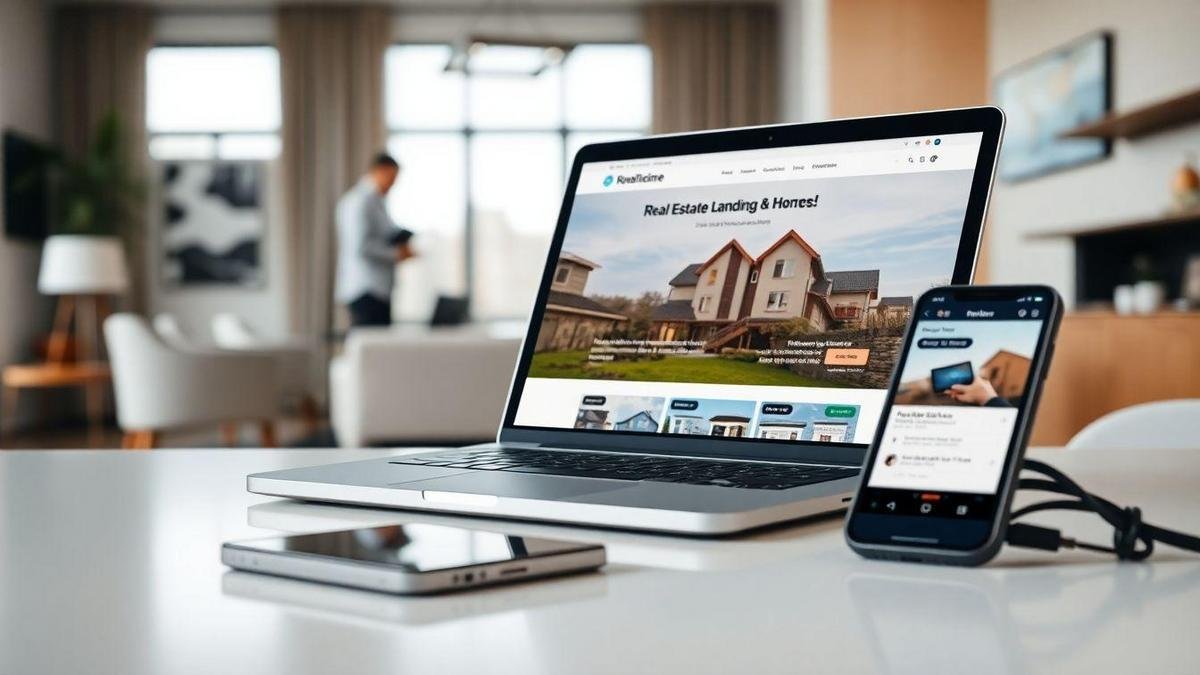Facebook ads for real estate developers gives clear, practical steps for selling property on Facebook. It helps developers set clear goals, pick audiences with location and demographic filters, explains lookalike audiences and precise audience setup, maps simple lead flows, form choices, and how to check lead quality. It provides ad copy that converts and creative briefs for video, carousel, and image ads. It guides budgeting and scaling, plus smart retargeting to warm buyers. It teaches A/B testing and simple rules for picking winners, shows how to match ads to landing pages, and ends with a compact action plan and checklists to launch fast.
Key Takeaway
- Target ads to neighborhoods and buyer interests.
- Use clear photos and short headlines.
- Add the Facebook Pixel to track visits and leads.
- Run simple A/B tests to compare ads.
- Use short contact forms to capture leads.

Facebook ads for real estate developers: core tips and strategy
Facebook ads for real estate developers must start with clarity. Know whether the aim is brand awareness, lead capture, or closing sales — that choice drives audience, creative, and budget. A developer who treats ads like a shotgun wastes money; one who treats them like a sniper wins. Clear objectives let the team pick the right ad type, control cost per lead (CPL), and measure what matters.
Creative and message must match the buyer’s stage. Early-stage prospects respond to video tours and lifestyle shots — pair those with guidance from proven video marketing playbooks. Mid-stage prospects want floor plans, incentives, and virtual tours. Late-stage buyers look for pricing, availability, and a fast call-to-action (CTA). Map content to stage and switch creatives when performance dips. Small A/B tests reveal which headlines or images push clicks and which push sign-ups.
Data beats gut feeling. Install the Facebook Pixel, set conversion events, and name them clearly. Track CTR, CPL, lead quality, and return on ad spend (ROAS) per campaign. Run short tests, scale winners, and pause losers. One developer doubled qualified leads by retargeting video viewers with a booking offer — proof that smart tracking pays.
Facebook ads tips for real estate developers to set clear goals
Pick a single primary objective per campaign: awareness for new projects, lead generation for interested prospects, or conversions for ready buyers. Mixing objectives makes results fuzzy.
Translate goals into measurable KPIs: target CPL, number of qualified appointments, and a follow-up timeline. Benchmark against past launches or local averages. When metrics drift, change one variable: audience, creative, or landing page. Tie objectives into your overall funnel — see how a clear sales funnel structures goals in the real estate sales funnel guide.
Best Facebook ad strategies for real estate developers for each project stage
- Pre-launch: focus on reach and interest. Use short videos, location-based targeting, and lookalikes seeded from website visitors. Gather emails and webinar sign-ups.
- Launch & sales: shift to lead capture and retargeting. Use carousel ads with unit options, lead forms with pre-filled fields, and retarget floorplan viewers. Offer time-limited incentives.
- Later: use dynamic ads and testimonials to nudge fence-sitters.
One-page action plan for campaign setup
Audience: custom list, lookalike, geo radius.
Creative: hero video, carousel, short copy.
Budget: small tests, scale winners.
Tracking: install Pixel, set conversion events.
Landing page: fast load, clear CTA, 3-field form.
Test: A/B for 3–7 days.
Optimize: pause poor performers, increase spend on top ads.
Follow-up: CRM integration and 24-hour lead response.

Facebook audience targeting for real estate developers and segments
Facebook audience targeting turns ad spend into leads by pointing ads at the right people. For real estate developers, the key is matching property segments to buyer profiles — condos to young professionals, family homes to parents, luxury to high-net-worth buyers. Using targeted social ads lets teams reach precise pockets of demand instead of shouting into the void. Short tests reveal which segments act like a magnet and which need a different message.
Feed the platform with CRM lists, pixel events, and offline conversions so Facebook can learn who converts. Split audiences by property type, budget, and buyer stage — people who viewed floorplans three times are hotter than general visitors. That saves money and speeds sales cycles. For audience seeding and lead tools, pair lists with modern lead-generation tools to improve match rates.
Think like a buyer: target first-time buyers with financing, investors with yield info. Layer location, behaviour, and demographics to move from broad awareness to hot leads. For broader channel ideas and content planning, review the social content playbook.
How to use demographic and location filters for property campaigns
Start with location: city, tight radius, or commuting belts; exclude areas unlikely to convert. Add age, household composition, and life events (recent relocations) to narrow to the buyer persona.
For an urban studio: choose young professionals, renters, grads. For family homes: target parents 30–45 interested in schools and parks. Test radius sizes and demographic mixes in parallel — small tweaks often improve lead quality.
Using lookalike audiences for real estate developer campaigns to find similar buyers
Lookalikes multiply success by finding people who mirror top customers. Feed Facebook a high-value seed (closed deals, high-LTV buyers) and build 1%–2% lookalikes. Smaller percentages give tighter matches; larger ones increase reach.
Create lookalikes from different seeds: buyers, serious leads, newsletter subscribers. Layer interests for context (e.g., lookalike interest in commercial real estate for investors). Exclude existing customers and test performance over time. For AI-assisted segmentation tips and automations that refine lookalikes, see AI in real estate sales and marketing.
Audience setup checklist for precise targeting
- Define seed lists: closed buyers, hot leads, event RSVPs
- Install pixel & map events: view content, lead, schedule tour
- Set location radius & exclusions: city, zip, commute rings
- Apply demographics: age, life events, household size
- Create lookalikes: 1% and 2% from best seeds
- Exclude customers & current leads
- Split-test audiences: compare at least 2 sets

How to generate leads on Facebook for property developers step by step
Start with a clear target: sell units, capture presales, or book site visits. Set a budget, pick creative (real photos or virtual tours), and use focused ads to reach buyers by location, income, and life events. Good creative: a short video or carousel plus a strong CTA like Book a tour or Get floorplans.
Typical process:
- Define target audience and objective (traffic, leads, messages).
- Launch split tests for creative and copy.
- Use a lead capture method (form, Messenger, landing page).
- Send leads into the CRM and trigger immediate follow-up.
- Measure CPL and rate of visits or tours.
Measure and follow up quickly. Track engagement, CPL, and conversion to site visits. If lead costs rise, pause poor ad sets, refresh creative, or tighten the audience.
Lead form options and when developers should use them
- Facebook Lead Ads (Instant Forms): fastest capture, pre-filled fields, great for mobile and gated assets (floorplans, brochures).
- Landing pages: better for higher-value projects — maps, specs, testimonials, and stronger tracking; see the checklist on website optimization for leads.
- Messenger ads: for two-way conversation and immediate qualification — pair with chatbots and automation for rapid responses.
How to track lead quality from Facebook campaigns
Use UTM tags and clear lead source fields in the CRM. Every lead should carry campaign name, ad set, and ad ID to trace creative to sale. Compare cost per lead to cost per tour and cost per sale.
Add simple lead scoring: points for phone numbers, requested documents, site visits booked, and calls answered. Use call-tracking numbers and log outcomes. Over time, shift budget to highest-converting ad sets. For tactics that improve conversion rates, consult conversion-rate guides.
Simple lead flow map for follow-up
Leads from Facebook → CRM. Automated email and SMS send the brochure within minutes. Sales rep gets a task to call within 24 hours. If the lead opens the brochure or clicks booking, elevate to hot and callback to schedule a visit. Tie this flow into marketing automation tools to speed responses.

Facebook ad copy examples for property developers that convert
Write ads that speak like a friendly guide: a short headline that names the benefit, a one-line description with a number or date, and an image showing a real room. Simple, visual messages tied to a clear next step convert best. Use the phrase Facebook ads for real estate developers when briefing partners to keep campaigns focused.
Good copy shows clear value and urgency without sounding pushy. Try headlines like “Save 15% on Reservation Fee” and descriptions that explain how. Test angles: lifestyle, investment, family life. Short lines, bold promises, and a friendly tone work well.
A winning ad mixes emotion and facts: one sentence that paints the scene — “Morning coffee on a sunlit balcony” — then a fact: price, size, or move-in date. A/B test images and copy together to spot high-performing combos.
Headline and description formats that developers can test
Rotate three headline formats:
- Benefit-first (what buyer gains)
- Location-first (where the property sits)
- Offer-first (price or promotion)
Pair descriptions with a single supporting fact and a short emotional line.
| Headline format | Example headline | Short description |
|---|---|---|
| Benefit-first | Save on monthly costs | Lower utilities with smart insulation. |
| Location-first | Central Shoreview Living | Walk to parks, shops, and transit. |
| Offer-first | Launch Prices from $199k | Limited units — first move-in Oct 2025. |
Call-to-action examples for sales and brochure requests
CTAs must match the ad goal. For brochures: “Get Brochure”, “Download Floorplans”, “See Full Spec”. For sales leads: “Book a Tour”, “Reserve Your Unit”, “Speak to a Sales Agent”. Match CTA to landing page and place it near a visual cue.
Quick copy checklist to boost clicks
- Headline: Promise one clear benefit.
- Description: Add one supporting fact.
- Image: Show a real interior or view.
- CTA: Match action to landing page.
- Urgency: Include a date or limited quantity.
- Proof: Add a short social or award line if space allows.

Creatives and ad formats for Facebook ads for real estate developers
Choose creative by the buyer’s stage. Awareness: bold images or short videos showing lifestyle. Consideration: carousels and longer walkthrough videos. Conversion: lead forms and collection ads for quick action. Mix formats to build a natural funnel.
Match creative to market segment: families — floor plans, schools, parks; investors — returns, rental demand, location data. Rule of thumb:
- Use video for motion and emotion.
- Use carousel for variety.
- Use single image for quick, bold messages.
When developers should use video, carousel, or single image
- Video: context, virtual tours, neighborhood ambience, testimonials (20–60s; hook in first 3–5s). For creative best practices and storyboarding, reference our video marketing guide.
- Carousel: multiple selling points or units (kitchen, balcony, amenities, floor plans).
- Single image: announcements, launch dates, pricing.
Best image sizes and video length for property ads
- Feed images: 1080 x 1080 (square) or 1200 x 628 (landscape); mobile feeds: 4:5 (1080 x 1350).
- Stories & Reels: 1080 x 1920 (vertical) — follow Instagram and Reels guidance.
- Aim for at least 1,200px on the shortest side and compress files.
- Videos: 15–30 seconds for awareness; up to 60 seconds for walkthroughs/testimonials. Use captions and MP4 format.
Creative asset brief developers can reuse
- Campaign goal: (Awareness / Leads / Sales)
- Target audience: (Age, location, buyer type)
- Core message: One clear benefit in 10 words or less
- Primary visual: (Hero shot / Unit type / Amenity) resolution (e.g., 1080×1080)
- Format & length: (Single image, Carousel, Video 15–30s)
- CTA: (Book tour, Learn more, Get pricing)
- Mandatory elements: Logo, contact, legal line if needed
- Variations: 3 headlines, 2 CTAs, 2 image crops
- Tracking: UTM, pixel events, landing page URL

Facebook ad budget allocation for real estate projects and pacing
Map budget to each sales stage: awareness, consideration, conversion. Allocate more early on to testing and audience learning so Facebook’s algorithm can perform.
Reserve a testing buffer (~10–20% of first-quarter spend) to try creatives, placements, and audiences. Pacing matters: rapid spend can burn the learning phase; too-slow pacing delays results. Set weekly milestones (CPM, CTR, CPL) and move budget to ads that hit those targets every 7–10 days.
How developers can split budget by objective and funnel stage
A common split for a new launch: 40% awareness, 40% consideration, 20% conversion. Awareness: large interest/lookalike audiences with video. Consideration: lead forms and content offers. Conversion: retarget high-intent users with floor plans, pricing, and booking CTAs.
Daily vs lifetime budgets and rules for scaling spend
- Daily budgets: tight control for small markets or short tests.
- Lifetime budgets: better for multi-week launches, let Facebook pace spend.
Scaling rules: increase budgets by 20–30% increments every 3–4 days and monitor the learning status. If CPA jumps, pause and test new creative or audience splits — slow ladders often win over overnight jumps. For paid media pacing templates and ROI benchmarks, review PPC campaign playbooks and our marketing ROI guide.
Budget template for a new development launch
3-month split: Month 1 (Testing & Awareness) 50% — broader reach and video; Month 2 (Lead Gen & Consideration) 30% — lead forms and landing pages; Month 3 (Conversion & Retargeting) 20% — appointments and offers. Keep 10–20% reserve for top-performing ad sets.

Retargeting strategies for real estate developers on Facebook
Retargeting is a second chance at a first impression. After a prospect visits, the Facebook Pixel captures intent. Build Custom Audiences from page views, property detail views, and abandoned forms. Short, relevant ads that follow a visitor feel like a polite nudge.
Segmenting matters: someone who viewed floor plans differs from someone who opened pricing. Create multiple audiences by behavior and time window (3-day hot vs 30-day warm). Use Dynamic Ads to surface the exact unit or floor plan viewed.
Combine formats: short video walkthrough, carousel of finishes, static ad with a clear CTA. Messenger or lead-gen forms can catch fence-sitters. The goal: move curiosity to contact without wearing people out. See advanced tactics in our guides on AI-powered retargeting and remarketing strategies.
How developers can retarget website visitors and lead form abandoners
Tag key pages and events with the Facebook Pixel and Conversions API. Create audiences for property pages, contact page visits, and form starts. For form abandoners, a 24–72 hour window performs best — quick follow-up can recover interest.
Match ads to the abandoned action: mortgage calculator abandoners see an explainer; pricing-step abandoners see fee breakdowns. Use low-friction CTAs like Book a quick call or See available units. Exclude recent converters.
Frequency and creative rotation rules to avoid ad fatigue
- Frequency cap: 3–7 impressions/week for retargeting audiences.
- Rotation cadence: refresh creative every 7–14 days for warm lists.
- Message mix: testimonial, walkthrough, incentive — pull ideas from content idea lists.
- Exclusions: remove recent converters for 30–60 days.
Retargeting sequence outline for warmer leads
- Days 0–3: gentle reminder — short video or carousel of viewed units.
- Days 4–7: social proof — client testimonials or case study.
- Days 8–14: urgency — limited-time pricing or open-house invite.
- After two weeks: light monthly nurture and pass high-engagement contacts to sales.

A/B testing Facebook ads for property developers to improve ROI
A/B testing gives a map — run two versions side by side to see what actually moves prospects. Track impressions, CTR, leads, CPL, and conversion rate on the landing page.
When running targeted campaigns, measure whether creative, copy, or audience is working. Each test must measure one change at a time. Start small and iterate; small wins compound into lower acquisition costs. For practical test plans and metrics, see our conversion improvement guide.
What developers should test first: creative, copy, or audience
Start with creative—visuals stop the scroll. If the project is unknown or market unclear, test audience early. If creative is strong, tweak copy (headline or CTA). Pick the variable most likely to move the needle.
- Start with one variable: Creative, Copy, or Audience.
How long tests should run and when to declare a winner
Aim for 7–14 days and a minimum of 20–50 leads per variant when possible. If leads are rare, lengthen the run. Cover weekdays and weekends.
Declare a winner when results are consistent: a stable cost advantage of >20% over at least 3 consecutive days and adequate sample size. If numbers swing, increase sample size before choosing.
Simple A/B test tracking sheet developers can use
Keep a spreadsheet with columns: Test name, Variable, Start date, End date, Impressions, Clicks, Leads, Cost, CPL, Winner. Record daily totals and note why a version likely won.
| Test name | Variable | Start date | End date | Impressions | Clicks | Leads | Cost | CPL | Winner |
|---|---|---|---|---|---|---|---|---|---|
| Launch Creative A vs B | Creative | 2025-09-01 | 2025-09-08 | 12,000 | 480 | 24 | $2,400 | $100 | A |
| Audience 1 vs 2 | Audience | 2025-09-09 | 2025-09-16 | 9,500 | 285 | 19 | $2,285 | $120 | 1 |

Landing page optimization for Facebook real estate leads and conversions
A landing page must act like a warm handshake after an ad click. The headline should mirror the ad to keep trust and cut bounce rates. Use high-quality photos, a clear starting price, and one short value sentence so visitors know fast what they get.
Speed and clarity are non-negotiable: compress images, limit widgets, and place the primary CTA above the fold. Simple forms with pre-filled fields or one-click actions reduce friction. Follow the technical and conversion checklist in website optimization for leads.
Trust elements close deals: recent sales, short testimonials, and a neighborhood map. Show visible contact options — phone, chat, or schedule — to turn clicks into leads.
Key elements developers must include on a property landing page
- Clear headline, hero image or video, succinct value proposition.
- CTA in two places: top button and after key details.
- Answer price, size, location, availability quickly.
- Testimonials, short FAQ, and a lead form with ≤3 fields.
- Floorplan download or virtual tour link; urgency signals if relevant.
How to match ad message to landing page for higher conversion
Consistency wins. If the ad promises “sea-view two-bedroom from $300k,” the landing page must show that model, price range, and a sea-view image. Match ad tone to page tone. Track UTMs and A/B test headlines and images — small tweaks often yield big lifts. For ROI-focused matching and testing, pair landing-page work with your paid media strategy in the marketing ROI guide.
Landing page checklist to turn clicks into leads
- Loads under 3 seconds
- Matching headline and hero from the ad
- One bold CTA
- Price or key offer visible
- At least one testimonial or recent sale
- Lead form under three fields
- Clear contact options
Why Facebook ads for real estate developers work
Facebook’s targeting and learning algorithms let developers find narrow pockets of demand and scale efficiently. When developers combine precise audiences, relevant creative, and fast follow-up, Facebook ads shorten sales cycles, lower CPL, and increase quality tours and sales. Combine these campaigns with a broader digital approach — see digital marketing strategies for multi-channel alignment.
Conclusion
Start with clarity and one primary objective, target audiences like a sniper, and match creative to the buyer’s stage. Install the Facebook Pixel, track key metrics, and treat campaigns as a live market — test, learn, and scale. Short A/B tests, tight audience splits, and bold CTAs feeding fast landing pages turn attention into real leads. Budget like a gardener: water early with a testing buffer, then shift spend to winners. Smart retargeting and regular creative rotation are polite nudges; prompt CRM follow-up converts interest into tours and sales. Prioritize measurement, relevance, and speed to lower CPL and lift ROI. For more templates, checklists, and practical guides, read more at https://realhubly.com.

No responses yet